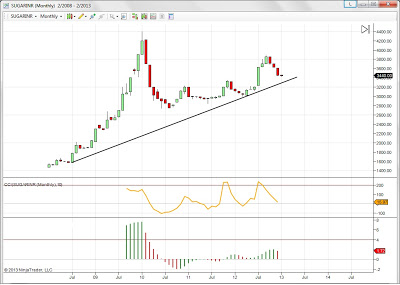Balarampur Chini MD continuing to expound on the industry dynamics…
Q. Do you think this test case of linking raw material costs and sugarrealisations is going to be watched with keen interest?
Absolutely. This is something that even the Rangarajan committee has indicated. De-reservation of cane area and a derived cane-price formula. The word “derived” is critical. It indicates that can price will not be an absolute but linked to another variable. In this case the cane price will be linked to the price of cane in the marketplace. The higher the rise in the sugar realisations the greater will be the price paid to the cane farmer.This is equitable for some valid reasons. The cane price will no longer be treated as an 'expense" in the conventional sense, but as a share of profits earned by the sugar companies. No longer will the cane grower be treated as a vendor, but as a partner.
Q. It might then be pertinent to understand what aspects of theliberalisation have not happened?
A. The big thing that has not happenedis cane decontrol. Clearly, the industryneeds to move towards raw materialreform, which, when it happens, couldlead to a complete sectoral decontrol.The operative word here is âlinkageâ;when we talk of cane decontrol, whatwe indicate is not that the pricing ofcane be completely decontrolled; whatwe indicate instead is that, as per thefindings of the Rangarajan Committeereport, the cost of cane be linked to therealisation of sugar in the free market.
This is an internationally-tested model:this ensures that any increase in thesectorâs profitability is equitably sharedbetween its manufacturers and growers.When we finally have a decontrolled rawmaterial side, we can truly claim thatreform and liberalisation have arrivedin Indiaâs sugar industry. At that point,every stakeholderâs interest will havebeen balanced, creating the foundationfor the business to attract more playersand investments.
The Rangarajan Committee has gonea step further in this proposed linkage;it has proposed a sharing percentageat a level higher than what is practicedabroad, which more than secures theinterest of farmers. Since this is anindividual state-based subject, this maybe more difficult to implement than adecision taken at the Centre. However,what is heartening is that within the firstcouple of months of deregulation, theKarnataka Government moved aheadwith the proposed linkage to deregulateraw material pricing from arbitrarygovernment pricing, a responsible stepfor the industry.
Q. How does de-reservation fit into the ongoing scheme of things?
A. Currently, a farmer can also sell to aspecific mill in his command area. In theproposed scheme of things(de-reservation), a farmer will be freeto sell his cane (full or part) to any millthat he wishes to. This will be in thefarmerâs benefit for a number of reasons:he will be free to market his cane towho ever pays him the highest andfastest, strengthening his cash flow. Inour opinion, this is the most powerfulantidote to mounting cane arrears.
Besides, the farmer will be able to enterinto back-to-back partnerships contractswith select mills not just for a season butfor a number of seasons, which, in turn,could make it possible for the mills to goahead and invest in higher capacities.
This we feel will create a robust industryfoundation. The sector has not seenfresh investments for years; thisde-reservation reform could provide itwith the impetus to bring funds backinto the industry. Dereservation couldalso free the farmar to sell the sugarcanewith the linkage of the sugar cane priceformula to protect him.
Q. If this represents a win-win situation, why is it not being implemented?
A. There are some vested politicalinterests who have until now enjoyeda ground level say in the fortunes ofthe countryâs sugar sector. A completedecontrol will mean that their interestswill be marginalised and the industryleft to a free interplay of marketplacedynamics.
The time has come for a complete rethink.Consider this: sugar is the largestsector in Uttar Pradesh and is sick; noinvestment has gone into enhancingcrushing capacities for years, aggregateindustry profits have declined, caneprices have only increased year-on-yearand yet cane arrears are at a record`6,000 cr.
This means that somethingfundamental has gone wrong. It wouldbe interesting to see what history iswilling to teach us: the governmentthat has inevitably raised cane pricesas a means to gather local supporthas inevitably lost the subsequentelection. This echoes an incident fromanother prominent Indian state wherethe government literally encouragedlabourers to become militant, promptinga flight of capital. This is what UttarPradesh needs to learn: that if policiesare win-win â in the balanced interestsof growers and manufacturers â therecan be hope of long-term prosperitybeing generated from that sector.
Q. What is the outlook for the sector and the Company for 2013-14?
A. There is no conventional businesslike the sugar business, but only if it canbe liberated from political control. Wherecan you get a sector where a profitablecore product generates two profitablespinoffs that serve demand-supply gapsthat are likely to linger well into thelong-term?
Where can you get a sectorthat has the potential to drive agriculturalprosperity hand in hand with industrialgrowth? Where can you get a sector thataddresses growing food requirementson the one hand and clean energyrequirement on the other?It is only a matter of time before thegovernment embarks on the completeliberalisation of one of the last vestigesof the pre-1991 era.
Based on thisoptimism, we are making a fresh capitalinvestment after six years; we areinvesting around `52 cr, which will add12.7 MW to our cogeneration capacity,with an attractive payback. Besides, weare contemplating investing in a distilleryonce the government clarifies the ethanolpolicy.

